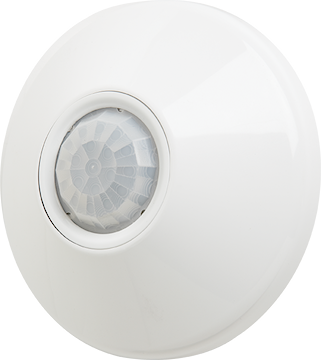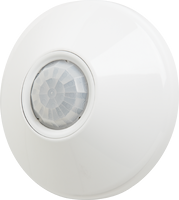The CM 9 Series occupancy sensor offers amazing performance and sensitivity to small motions for a standard range Passive Infrared (PIR) sensor. Ideal for small rooms with drop ceilings and areas without obstructions, the CM 9 is a snap to install. Its light weight allows surface mounting to drop ceilings or a ceiling grid. The CM 9 sensor can cover entire private offices or smaller rooms by itself, however it is also the ideal lead sensor for odd shaped rooms. For example, a CM 9 in a restroom vestibule can communicate with a CM PDT 9 Dual Technology sensor in a main stall area. Another application is a CM 9 covering an entrance hall to a classroom and communicating with a WV PDT 16 sensor covering the main room. In both cases the lights would be activated on by the CM 9. Sensor operation: The sensor detects changes in the infrared energy given off by occupants as they move within the field-of-view. When occupancy is detected, a DC output goes high and can drive up to 200 mA of connected load. The sensor is powered with 12-24 VAC/VDC and typically operates with a PP20 or MP20 power pack, enabling complete 20 Amp circuits to be controlled. This innovative sensor requires no field calibration or sensitivity adjustments. Lampmaximizer: This sensor also contains patent pending LampMaximizer technology that allows users to aggressively target energy savings while still protecting lamp life. A minimum on timer, factory set at 15 minutes, helps preserve lamp life by eliminating all lamp cycles shorter than lamp manufacturer recommendations. A standard occupancy time delay is also present that ensures lights turn off (assuming minimum on timer has elapsed) if no occupancy is detected. This timer is factory set at 10 minutes to promote energy savings, but is adjustable between 30 seconds and 20 minutes. These adjustments can be done manually, through the unit’s push-button, or automatically every two weeks through an advanced mode, called LampMaximizer+, that determines the optimum time delay in order to maximize both lamp life and energy savings. Additionally, this sensor maintains statistics on total lamp on time and number of cycles. Low voltage relay (R): Enables sensors to interface with other systems (e.g., BMS, lighting panels). Provides dry contact closure via a SPDT, 1 Amp, 40 Volt relay. Only one relay needed per zone. Changes state when all connected sensors register unoccupied . Relay requires sensor power to function.











